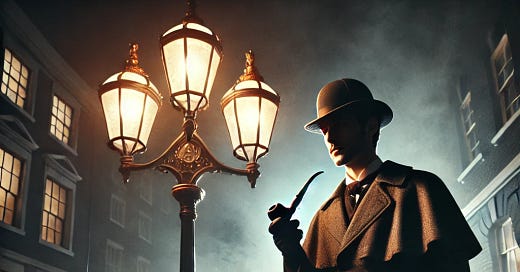Sherlock Holmes: A Picture That Tells a Thousand Stories
"The Timeless Silhouette of a Legendary Detective"
The streets of Victorian London are shrouded in mist, with the glow of gas lamps flickering through the dense fog. A solitary figure stands at the edge of Baker Street, his keen eyes scanning the surroundings like a living machine of logic and deduction. He is tall and slender, draped in an Inverness cape that gently billows in the night breeze. The deerstalker hat firmly rests on his head, and between his fingers, a curved pipe smolders, sending wisps of smoke curling into the damp air.
Without a single word spoken, his identity is unmistakable.
He is Sherlock Holmes—the world’s greatest detective. While Sir Arthur Conan Doyle brought him to life through words, it is his image that has solidified his place in history. A single depiction of Holmes, in any form, narrates a myriad of tales.
A Silent Introduction to a Brilliant Mind
What makes Sherlock Holmes instantly recognizable, even to those unfamiliar with his adventures? It is the power of visual storytelling.
His deerstalker hat—though never explicitly described in the original stories—has become a universal symbol of intellect and investigation. It signifies a man of action, a detective who ventures into the world rather than solving mysteries from behind a desk. His pipe, often curved or long-stemmed, suggests contemplation and deep thought, embodying the essence of his methodical mind at work. His cape and suit, always meticulously arranged, indicate a man of precision, logic, and order.
Even his body language conveys volumes. A furrowed brow, an intense gaze, the delicate tracing of a footprint’s edge—each movement silently reveals his character. Without a single line of dialogue, we grasp that he is a man who perceives what others overlook, who listens to the unspoken, and who assembles puzzles long before others realize they exist.
The Power of a Single Glance
A truly exceptional detective does not need to announce his presence; the world yields to his scrutiny. Picture Sherlock Holmes at a crime scene, his sharp eyes darting from one clue to the next. While onlookers—bewildered police officers and confused witnesses—see only disorder, Holmes discerns hidden order within the chaos.
A scattered pile of ashes reveals the brand of the suspect’s cigarette. A muddy footprint near the window hints at a hasty escape, the depth of the imprint disclosing the intruder’s weight. A thread snagged on a nail implies a torn sleeve—a potential oversight by a criminal who believed he left no trace.
Holmes requires no explanation; his eyes alone narrate the tale.
A Timeless Silhouette
Few literary characters boast an image as iconic as Sherlock Holmes. Throughout the years, numerous actors have embodied him, each offering a unique interpretation. Basil Rathbone’s classic portrayal in early films presented the refined, dignified detective. Jeremy Brett’s sharp and intense Holmes brought profound psychological depth to the character. Robert Downey Jr.’s action-oriented rendition introduced rugged energy, while Benedict Cumberbatch’s modern-day detective reimagined the legend for the digital era.
Nevertheless, regardless of the reinterpretations, Holmes's essence remains unaltered. A single silhouette—tall, focused, pipe in hand, lost in thought—is all that is needed for recognition.
The Picture That Paints a Thousand Words
Ultimately, Sherlock Holmes transcends being merely a detective; he embodies an idea, a symbol of pure observation and logic. His mere presence tells a story even before he utters the words, "The game is afoot!" A single image of him can transport us into a world of mystery, where the smallest clue holds immense significance and where no crime remains unsolved.
While some stories demand numerous pages to unfold, with Holmes, a single glance at his hat, his pipe, his calculating eyes—conveys all we need to know. In his case, the age-old adage rings true: a picture paints a thousand words.




